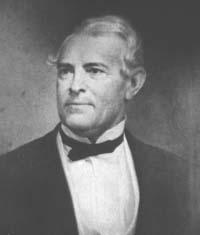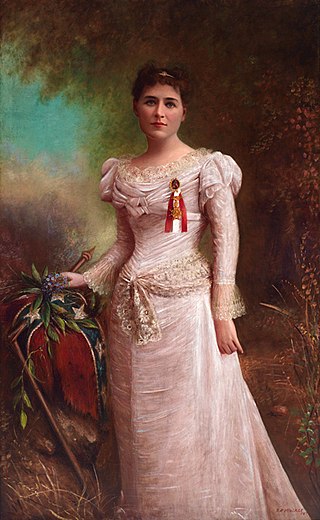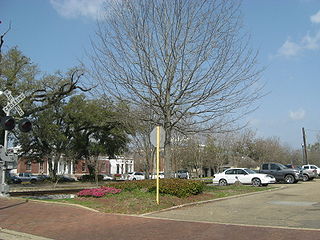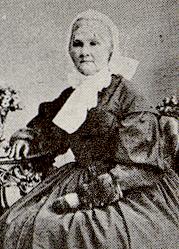
Jefferson F. Davis was an American politician who served as the first and only president of the Confederate States from 1861 to 1865. He represented Mississippi in the United States Senate and the House of Representatives as a member of the Democratic Party before the American Civil War. He was the United States Secretary of War from 1853 to 1857.

Pierre Gustave Toutant-Beauregard was an American military officer known as being the Confederate General who started the American Civil War at the battle of Fort Sumter on April 12, 1861. Today, he is commonly referred to as P. G. T. Beauregard, but he rarely used his first name as an adult. He signed correspondence as G. T. Beauregard.

The Confederate States Army, also called the Confederate Army or the Southern Army, was the military land force of the Confederate States of America during the American Civil War (1861–1865), fighting against the United States forces to win the independence of the Southern states and uphold and expand the institution of slavery. On February 28, 1861, the Provisional Confederate Congress established a provisional volunteer army and gave control over military operations and authority for mustering state forces and volunteers to the newly chosen Confederate States president, Jefferson Davis (1808-1889),. Davis was a graduate of the United States Military Academy, on the Hudson River at West Point, New York, colonel of a volunteer regiment during the Mexican–American War (1846-1848). He had also been a United States senator from Mississippi and served as U.S. Secretary of War under 14th President Franklin Pierce. On March 1, 1861, on behalf of the new Confederate States government, Davis assumed control of the military situation at Charleston Harbor in Charleston, South Carolina, where South Carolina state militia had besieged the longtime Federal Fort Sumter in Charleston harbor, held by a small U.S. Army garrison under the command of Major Robert Anderson. (1805-1871). By March 1861, the Provisional Congress of the Confederate States meeting in the temporary capital of Montgomery, Alabama, expanded the provisional military forces and established a more permanent regular Confederate States Army.

Varina Anne Banks Davis was the only First Lady of the Confederate States of America, and the longtime second wife of President Jefferson Davis. She moved to the presidential mansion in Richmond, Virginia, in mid-1861, and lived there for the remainder of the Civil War. Born and raised in the Southern United States and educated in Philadelphia, she had family on both sides of the conflict and unconventional views for a woman in her public role. She did not support the Confederacy's position on slavery, and was ambivalent about the war.

Sarah Knox Davis was the daughter of the 12th U.S. president Zachary Taylor and part of the notable Lee family. She met future Confederate president Jefferson Davis (1808–1889) when living with her father and family at Fort Crawford during the Black Hawk War in 1832. They married in 1835 and she died three months later of malaria.

George Alfred Trenholm was a South Carolina businessman, financier, politician, and slaveholding planter who owned several plantations and strongly supported the Confederate States of America. He was appointed as its Secretary of the Treasury during the final year of the American Civil War.

Sarah Anne Dorsey was an American novelist and historian from the prominent southern Percy family. She published several novels and a highly regarded biography of Henry Watkins Allen, governor of Louisiana during the years of the American Civil War. It is considered an important contribution to the literature of the Lost Cause of the Confederacy.

Louisiana was a dominant population center in the southwest of the Confederate States of America, controlling the wealthy trade center of New Orleans, and contributing the French Creole and Cajun populations to the demographic composition of a predominantly Anglo-American country. In the antebellum period, Louisiana was a slave state, where enslaved African Americans had comprised the majority of the population during the eighteenth-century French and Spanish dominations. By the time the United States acquired the territory (1803) and Louisiana became a state (1812), the institution of slavery was entrenched. By 1860, 47% of the state's population were enslaved, though the state also had one of the largest free black populations in the United States. Much of the white population, particularly in the cities, supported slavery, while pockets of support for the U.S. and its government existed in the more rural areas.
The bibliography of the American Civil War comprises books that deal in large part with the American Civil War. There are over 60,000 books on the war, with more appearing each month. Authors James Lincoln Collier and Christopher Collier stated in 2012, "No event in American history has been so thoroughly studied, not merely by historians, but by tens of thousands of other Americans who have made the war their hobby. Perhaps a hundred thousand books have been published about the Civil War."

The conclusion of the American Civil War commenced with the articles of surrender agreement of the Army of Northern Virginia on April 9, at Appomattox Court House, by General Robert E. Lee and concluded with the surrender of the CSS Shenandoah on November 6, 1865, bringing the hostilities of the American Civil War to a close. Legally, the war did not end until a proclamation by President Andrew Johnson on August 20, 1866, when he declared "that the said insurrection is at an end and that peace, order, tranquillity, and civil authority now exist in and throughout the whole of the United States of America."

Varina Anne "Winnie" Davis was an American author who is best known as the youngest daughter of President Jefferson Davis of the Confederate States of America and Varina (Howell) Davis. Born near the end of the war, by the late 1880s she became known as the "Daughter of the Confederacy". Images of her were widely circulated when she was young, helping morale. Later in the 1880s, she appeared with her father on behalf of Confederate veterans' groups. After his death, she and her mother moved in 1891 to New York City, where they both worked as writers. She published a biography and two novels, in addition to numerous articles. Davis died from an infectious disease at age 34.

The New Orleans, Jackson and Great Northern was a 206-mile (332 km) 5 ft gauge railway originally commissioned by the State of Illinois, with both Stephen Douglas and Abraham Lincoln being among its supporters in the 1851 Illinois Legislature. It connected Canton, Mississippi, with New Orleans and was completed just prior to the American Civil War, in which it served strategic interests, especially for the Confederacy. The New Orleans, Jackson and Great Northern was largely in ruins by the end of the War. From 1866 to 1870, when a hostile takeover induced a change of leadership, the president of the New Orleans, Jackson and Great Northern was P. G. T. Beauregard (1818-1893), former Confederate States Army general under whose command the first shots had been fired on Fort Sumter and who during the war helped design the Confederate battle flag. James Robb (banker) was a director.

Joseph Emory Davis was an American lawyer who became one of the wealthiest planters in Mississippi in the antebellum era; he owned thousands of acres of land and was among the nine men in Mississippi who owned more than 300 slaves. He was the elder brother of Jefferson Davis and acted as his surrogate father for several years. The younger Davis became a politician, U.S. Senator, and later President of the Confederacy.
The American Civil War bibliography comprises books that deal in large part with the American Civil War. There are over 60,000 books on the war, with more appearing each month. There is no complete bibliography to the war; the largest guide to books is over 40 years old and lists over 6,000 titles selected by leading scholars. Many specialized topics such as Abraham Lincoln, women, and medicine have their own lengthy bibliographies. The books on major campaigns typically contain their own specialized guides to the sources and literature. The most comprehensive guide to the historiography annotates over a thousand titles.
When Jefferson Davis died on December 6, 1889, his funeral was a major event in the United States, receiving front-page attention throughout the country. By the time of his death, Davis had become a transitional figure. He was the embodiment of the Old South, who lived long enough to be seen as emblematic of the New South. Davis's funeral and reburial is also symbolic of his problematic legacy as a leader of the Confederate States of America and its role in the perpetuation of slavery.
Jefferson Davis: The Man and His Hour is a 1991 book by William C. Davis, published by HarperCollins Publishers. It is a biography of Jefferson Davis.

Margaret Louisa Kempe Howell was an American heiress, planter, and slaveowner who was the mother of Confederate First Lady Varina Davis and mother-in-law of Confederate President Jefferson Davis. Upon her marriage to the son of New Jersey Governor Richard Howell, her father granted her a dowry of sixty slaves and two thousand acres of land in Mississippi. She and her husband faced financial difficulties throughout their lives and depended on the support of her family. After their plantation was seized by creditors, they rented a mansion known as The Briars from John Perkins Sr. Following the American Civil War, Howell fled to Canada, where she died.
Jefferson Davis: Unconquerable Heart is a 1999 non-fiction book by Felicity Allen, published by the University of Missouri Press, about Jefferson Davis.
First Lady of the Confederacy: Varina Davis's Civil War is a 2006 book by Joan E. Cashin, published by Harvard University Press. Its subject is Varina Davis.













